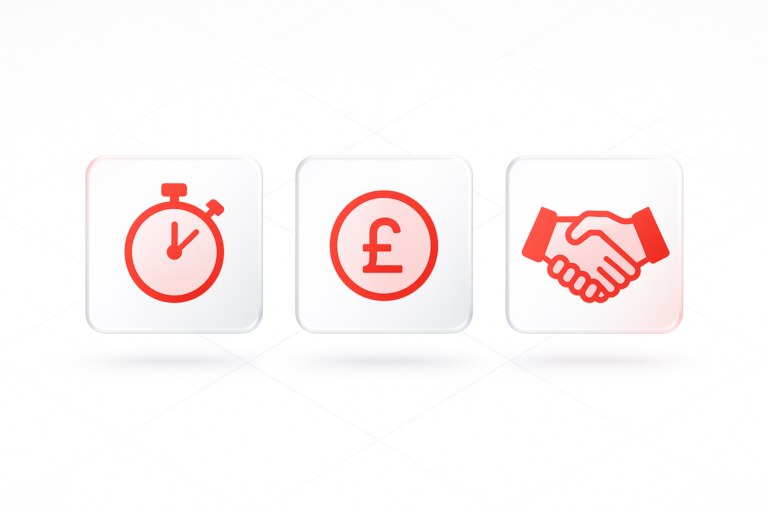
- Blog, Business Growth
- By Grahame Simpson
The Smarter Way to Grow: Save Time, Cut Costs, and Build a Better Business
Introduction
Ask most business owners what “growth” looks like, and they’ll often picture more clients, more sales, and more hours worked. But growth doesn’t always have to mean running faster on the treadmill.
Real growth can come from saving money, building better systems, and creating stronger client relationships — as well as winning new customers. And often, it’s these smarter approaches that make growth more sustainable (and far less stressful).
This article looks at the different ways businesses can grow, why saving time and money is just as important as bringing in sales, and how focusing on the right kind of growth creates stronger, more profitable companies.
Contents
In this article, we’ll cover:
- Why growth feels hard for many businesses
- The different types of growth
- Where time gets lost (and how to win it back)
- Why saving money fuels growth
- Building systems that free you to grow
- Focusing on better customers (not just more)
- The role of relationships in sustainable growth
- Conclusion
The Different Types of Growth
When most people think of growth, they imagine getting more customers. But there are many different paths to growing a business — and often the smartest growth comes from areas that aren’t about chasing volume.
Here are five types of growth worth focusing on:
- Growth through savings → Cutting waste is one of the fastest ways to grow profit. That could mean trimming unnecessary expenses, cancelling unused subscriptions, or finding more efficient ways of working. Every pound saved is a pound that can be reinvested in growth.
- Growth through systems → Strong systems make businesses scalable. Automating follow-ups, organising data, or streamlining onboarding means less firefighting and more time to focus on higher-value work.
- Growth through new customers → Bringing in more clients is important, but it works best when it’s targeted. Smart lead generation ensures you attract the right people, not just anyone.
- Growth through better customers → Not all customers are equal. Fewer, higher-value clients often bring more profit and less stress than chasing dozens of small, low-margin ones.
- Growth through stronger relationships → Loyal clients come back and refer others. Investing in trust and communication creates steady, repeatable business.
Growth isn’t just about doing more. It’s about choosing smarter — focusing on the areas that create stability, profitability, and long-term success.
Where Time Gets Lost (and How to Win It Back)
Time is one of the most valuable assets in any business — yet it’s also the one most often wasted. Many owners don’t realise how much growth is held back simply because too many hours disappear into low-value tasks.
Here are some of the biggest time drains:
- Admin overload → Manually sending invoices, chasing payments, or tracking work in messy spreadsheets.
- Inefficient marketing → Spending hours posting on social media without a plan, or running ads that aren’t properly targeted.
- Reactive work → Jumping from one problem to the next instead of following a clear plan.
- Repetition → Writing the same emails, answering the same questions, or doing the same small tasks over and over.
The problem isn’t working hard — it’s working in the wrong places.
Winning back time comes from:
- Automating repetitive tasks (emails, reminders, follow-ups).
- Planning marketing properly instead of guessing.
- Prioritising high-value work that moves the business forward.
- Building systems that keep things organised and reduce daily stress.
When time is freed up, growth stops being about longer hours — it becomes about working smarter.

Why Saving Money Fuels Growth
It’s easy to think growth only comes from earning more. But often, the fastest way to improve profitability is by spending less on the wrong things.
For many SMEs and consultants, money is lost in:
- Inefficient marketing → broad ad campaigns that reach the wrong audience.
- Unnecessary tools and subscriptions → paying for software or services that don’t get used.
- Manual processes → paying with time instead of investing in systems that save both time and money.
Every pound wasted is a pound that could have been reinvested in smarter growth.
On the flip side, businesses that keep a close eye on efficiency can often grow faster without chasing extra sales. For example:
- A better system might save 5 hours a week in admin.
- Smarter targeting might halve ad spend while delivering the same leads.
- A focus on retention might reduce the need to constantly replace lost customers.

“Small businesses waste an average of 20% of their budget on ineffective marketing each year (Forbes).”
Growth isn’t just about chasing more revenue. It’s about making sure what you already spend is working as hard as possible.
Building Systems That Free You to Grow
One of the biggest turning points for a business is moving from “everything in your head” to systems that run in the background.
Without systems, every task feels urgent, every client needs manual attention, and growth is limited by how many hours you can personally work. With systems, things start to flow.
Examples of growth-focused systems include:
- Automated follow-ups → never forget to chase a lead or update a client.
- Streamlined onboarding → clients get the same smooth experience every time.
- Organised data and communication → less time wasted searching for information.
- Templates and processes → emails, proposals, or tasks handled in minutes instead of hours.
The benefit isn’t just efficiency. Systems create consistency, and consistency builds trust. Clients know what to expect, staff (if you have them) know what to do, and you’re free to focus on higher-value growth work.
Think of systems as the foundation that allows you to scale. Without them, growth is like building on sand — unstable and stressful. With them, growth becomes sustainable.

Focusing on Better Customers (Not Just More)
It’s tempting to think growth is about “more, more, more.” More leads, more sales, more clients. But in reality, not all customers are equal.
Some clients bring higher revenue, respect your time, and are a pleasure to work with. Others take more energy than they’re worth. Growth comes from recognising the difference — and choosing to focus on better clients, not just more of them.
Here’s why better customers fuel stronger growth:
- Higher-value work → Fewer jobs or contracts can deliver more profit than chasing dozens of low-margin ones.
- Less stress → The right clients trust your expertise, instead of haggling over every detail.
- Stronger loyalty → Good-fit clients stick around longer and are more likely to refer you.
Example: A consultant may find that instead of signing ten low-fee clients, focusing on three larger, well-matched clients creates more income, less admin, and better results.
The lesson: chasing volume often creates chaos. Choosing quality creates clarity, stability, and higher profits.
The Role of Relationships in Sustainable Growth
Growth isn’t only about transactions — it’s about trust. A strong relationship with clients can deliver more value over time than constantly chasing new leads.
Here’s why relationships matter so much:
- Repeat business → Existing clients already know and trust you, making them easier to serve again.
- Referrals → Happy clients recommend you to others, creating warm leads without extra effort.
- Loyalty through trust → When clients feel valued and supported, they’re less likely to shop around.
- Long-term stability → Strong relationships create predictable income and reduce the “feast and famine” cycle.
Example: A trades business that sends seasonal reminders (“time to service your boiler”) not only wins repeat jobs but also shows clients they care. The relationship is strengthened, and the work becomes steady year after year.

In the end, relationships aren’t just a “nice to have.” They’re one of the strongest assets a business can build — and one of the smartest ways to grow.
Conclusion
Business growth doesn’t have to mean working longer hours, taking on more stress, or constantly chasing the next sale. Real growth comes from being smarter — saving time, cutting waste, building systems, and focusing on the right clients and relationships.
When you start to see growth in these different ways — through savings, systems, better customers, and stronger relationships — you build a business that’s not only more profitable but also more enjoyable to run.
If you’re looking for smarter ways to grow, start by asking yourself:
- Where am I losing time each week?
- Where is money being wasted?
- Which clients give me the best results — and how can I find more like them?
- What systems would make my work easier and more consistent?
The answers to those questions will show you where your next stage of growth really lies.
Related Posts

AI for Small Business: Smarter Tools for Time, Money, and Growth

